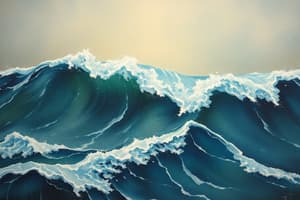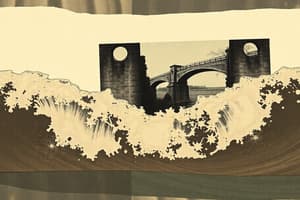Podcast
Questions and Answers
What type of image is formed by a converging lens for long-sighted eyes?
What type of image is formed by a converging lens for long-sighted eyes?
An enlarged and upright image is formed.
List the seven colors of light as they appear in a prism in order of decreasing wavelength.
List the seven colors of light as they appear in a prism in order of decreasing wavelength.
Red, orange, yellow, green, blue, indigo, violet.
What effect does wavelength have on the speed of light in glass?
What effect does wavelength have on the speed of light in glass?
Longer wavelengths travel slower in glass.
Describe the relationship between wavelength and frequency in electromagnetic waves.
Describe the relationship between wavelength and frequency in electromagnetic waves.
What is the main use of microwaves in technology?
What is the main use of microwaves in technology?
What potential hazard is associated with excessive exposure to ultraviolet light?
What potential hazard is associated with excessive exposure to ultraviolet light?
Explain how X-rays are used in the medical field.
Explain how X-rays are used in the medical field.
What type of radiation is used in remote controllers?
What type of radiation is used in remote controllers?
What happens to waves when they encounter a narrow gap or an obstacle?
What happens to waves when they encounter a narrow gap or an obstacle?
How does the wavelength of waves change when they move from deep to shallow water?
How does the wavelength of waves change when they move from deep to shallow water?
Can you explain the law of reflection using a ripple tank setup?
Can you explain the law of reflection using a ripple tank setup?
What is the relationship between the gap size and the amount of diffraction experienced by waves?
What is the relationship between the gap size and the amount of diffraction experienced by waves?
How does a barrier affect the behavior of waves encountering its edge?
How does a barrier affect the behavior of waves encountering its edge?
Describe how the speed of waves is affected by the water depth in a ripple tank.
Describe how the speed of waves is affected by the water depth in a ripple tank.
Why do longer wavelengths diffract more than shorter wavelengths when encountering obstacles?
Why do longer wavelengths diffract more than shorter wavelengths when encountering obstacles?
In a ripple tank, what role does the vibrating paddle play in wave generation?
In a ripple tank, what role does the vibrating paddle play in wave generation?
What types of radiation can lead to mutations and possibly cancer?
What types of radiation can lead to mutations and possibly cancer?
Why are microwaves preferred for communication with satellites?
Why are microwaves preferred for communication with satellites?
What is the speed of electromagnetic waves in a vacuum?
What is the speed of electromagnetic waves in a vacuum?
In what way do digital signals differ from analogue signals?
In what way do digital signals differ from analogue signals?
What is the primary advantage of using digital signals in communication?
What is the primary advantage of using digital signals in communication?
What is the function of optical fibres in communication systems?
What is the function of optical fibres in communication systems?
How do microwaves and radio waves differ in their use for Bluetooth technology?
How do microwaves and radio waves differ in their use for Bluetooth technology?
What type of satellites are mainly used for direct broadcast satellite TV?
What type of satellites are mainly used for direct broadcast satellite TV?
What is the definition of amplitude in wave motion?
What is the definition of amplitude in wave motion?
Explain the relationship between speed, frequency, and wavelength in wave motion.
Explain the relationship between speed, frequency, and wavelength in wave motion.
What are the key differences between transverse and longitudinal waves?
What are the key differences between transverse and longitudinal waves?
How does reflection of waves occur on smooth surfaces?
How does reflection of waves occur on smooth surfaces?
What happens to a wave's speed and direction when it enters a more optically dense medium?
What happens to a wave's speed and direction when it enters a more optically dense medium?
Describe the impact of rough surfaces on wave reflection.
Describe the impact of rough surfaces on wave reflection.
What is a wavefront and why is it significant in wave motion?
What is a wavefront and why is it significant in wave motion?
How does the frequency of a wave change when it is refracted?
How does the frequency of a wave change when it is refracted?
What is the definition of the refractive index n?
What is the definition of the refractive index n?
How does Snell's law relate the angles of incidence and refraction?
How does Snell's law relate the angles of incidence and refraction?
What condition must be met for total internal reflection to occur?
What condition must be met for total internal reflection to occur?
What does the critical angle represent in terms of refraction?
What does the critical angle represent in terms of refraction?
What is the function of optical fibers in communication?
What is the function of optical fibers in communication?
What characterizes a converging lens?
What characterizes a converging lens?
When is an image formed by a converging lens considered real?
When is an image formed by a converging lens considered real?
What differentiates a virtual image from a real image in lens optics?
What differentiates a virtual image from a real image in lens optics?
How does the amplitude of a sound wave affect its loudness?
How does the amplitude of a sound wave affect its loudness?
What is the relationship between the frequency of a sound wave and its pitch?
What is the relationship between the frequency of a sound wave and its pitch?
What formula is used to calculate the speed of sound, and what factors must be considered?
What formula is used to calculate the speed of sound, and what factors must be considered?
What is the speed of sound in air at room temperature?
What is the speed of sound in air at room temperature?
Define ultrasound and provide an example of its application.
Define ultrasound and provide an example of its application.
What are compressions and rarefactions in the context of sound waves?
What are compressions and rarefactions in the context of sound waves?
Why does sound travel faster in solids compared to gases?
Why does sound travel faster in solids compared to gases?
How does sonar use ultrasound to detect material flaws?
How does sonar use ultrasound to detect material flaws?
Flashcards
Diffraction
Diffraction
Waves spread out when passing around obstacles or through narrow gaps.
Diffraction: Gap & Wavelength
Diffraction: Gap & Wavelength
The narrower the gap or the greater the wavelength, the more the wave spreads out.
Reflection
Reflection
Waves bounce off a surface, changing direction but maintaining the same angle of approach and departure.
Refraction
Refraction
Signup and view all the flashcards
Refraction in Water
Refraction in Water
Signup and view all the flashcards
Diffraction through a Gap
Diffraction through a Gap
Signup and view all the flashcards
Diffraction around an Edge
Diffraction around an Edge
Signup and view all the flashcards
Diffraction & Wavelength
Diffraction & Wavelength
Signup and view all the flashcards
Amplitude
Amplitude
Signup and view all the flashcards
Wavelength
Wavelength
Signup and view all the flashcards
Frequency
Frequency
Signup and view all the flashcards
Speed
Speed
Signup and view all the flashcards
Transverse waves
Transverse waves
Signup and view all the flashcards
Longitudinal waves
Longitudinal waves
Signup and view all the flashcards
Refractive Index (n)
Refractive Index (n)
Signup and view all the flashcards
Snell's Law
Snell's Law
Signup and view all the flashcards
Critical Angle
Critical Angle
Signup and view all the flashcards
Total Internal Reflection
Total Internal Reflection
Signup and view all the flashcards
Converging Lens
Converging Lens
Signup and view all the flashcards
Focal Length
Focal Length
Signup and view all the flashcards
Real Image
Real Image
Signup and view all the flashcards
Virtual Image
Virtual Image
Signup and view all the flashcards
Diverging lens
Diverging lens
Signup and view all the flashcards
Dispersion of light
Dispersion of light
Signup and view all the flashcards
Electromagnetic waves
Electromagnetic waves
Signup and view all the flashcards
Electromagnetic spectrum
Electromagnetic spectrum
Signup and view all the flashcards
Radio waves
Radio waves
Signup and view all the flashcards
Microwaves
Microwaves
Signup and view all the flashcards
Infrared radiation
Infrared radiation
Signup and view all the flashcards
Satellite Communication
Satellite Communication
Signup and view all the flashcards
Low Orbit Satellites
Low Orbit Satellites
Signup and view all the flashcards
Geostationary Satellites
Geostationary Satellites
Signup and view all the flashcards
Speed of Electromagnetic Waves
Speed of Electromagnetic Waves
Signup and view all the flashcards
Mobile Phone and Wireless Internet Communication
Mobile Phone and Wireless Internet Communication
Signup and view all the flashcards
Bluetooth Communication
Bluetooth Communication
Signup and view all the flashcards
Optical Fiber Communication
Optical Fiber Communication
Signup and view all the flashcards
Digital vs. Analogue Signals
Digital vs. Analogue Signals
Signup and view all the flashcards
What are sound waves?
What are sound waves?
Signup and view all the flashcards
How does the speed of sound change in different media?
How does the speed of sound change in different media?
Signup and view all the flashcards
What determines the loudness of a sound wave?
What determines the loudness of a sound wave?
Signup and view all the flashcards
What determines the pitch of a sound wave?
What determines the pitch of a sound wave?
Signup and view all the flashcards
What is ultrasound?
What is ultrasound?
Signup and view all the flashcards
How is ultrasound used?
How is ultrasound used?
Signup and view all the flashcards
What are compressions and rarefactions in a sound wave?
What are compressions and rarefactions in a sound wave?
Signup and view all the flashcards
What is SONAR?
What is SONAR?
Signup and view all the flashcards
Study Notes
Wave Properties
- Waves transfer energy without matter transfer, particles oscillate about a point
- Amplitude: Distance from equilibrium to maximum displacement
- Wavelength: Distance between a point on one wave and same point on adjacent wave
- Frequency: Number of waves passing a point per second
- Speed: Distance a wave travels per second
- Speed = frequency × wavelength (v = fλ)
Types of Waves
- Transverse waves: vibrations at right angles to travel direction
- Examples: light waves, ripples on water
- Longitudinal waves: vibrations parallel to travel direction
- Examples: sound waves
Reflection
- Waves reflect off smooth surfaces; angle of incidence = angle of reflection
- Rough surfaces scatter light, appearing matte
Refraction
- Wave speed changes when entering new medium
- More optically dense medium: speed decreases, bends towards the normal
- Less optically dense medium: speed increases, bends away from the normal
- Frequency unchanged, wavelength changes
Diffraction
- Waves spread out when passing through gaps or around obstacles
- Narrower gap or larger wavelength = more diffraction
Light Reflection
- Light changes direction when reflected from a surface
- Angle of incidence = angle of reflection
- Normal: A line perpendicular to the reflecting surface at the point of incidence
- Angle of incidence (i): Angle between the incident ray and the normal
- Angle of reflection (r): Angle between the reflected ray and the normal
Plane Mirrors
- Image characteristics: same size as object, same distance behind mirror as object is in front, virtual (not seen directly), laterally inverted
- Law of reflection: i = r
- Construction, measurements, and calculations: diagrams, protractor for measurements, and geometry for calculations to locate images
Refraction of Light
- Light changes speed when passing through different mediums.
- More optically dense medium -> light bends towards the normal
- Less optically dense medium -> light bends away from the normal
- Critical angle: specific angle where light travels along the boundary between mediums
- Total internal reflection: light reflects back into the denser medium when angle of incidence > critical angle.
Optical Fibres
- Transfer information as light travels through glass fibres
- Utilized Total Internal Reflection
Thin Lenses
- Converging lenses bring light rays together at a principal focus
- Focal length: distance between center of lens and principal focus
- Real image: formed when object is further from the lens than the focal length
- Light actually converges to create the image
- Can be shown on a screen
- Virtual image: formed when object is closer to the lens than the focal length
- Light appears to converge to create the image
- Cannot be shown on a screen
- Real images are inverted, virtual images are upright
- Use in magnifying glasses, binoculars, and correcting vision problems (eyesight)
Dispersion of Light
- White light separates into colours when passing through a prism due to different speeds of different colours in glass
- Red has largest wavelength, Violet has smallest
- Different colours refract by different amounts
Electromagnetic Spectrum
- Waves that do not need a medium to travel in
- All travel at the same speed in a vacuum.
- Used for various communication methods
- Their energy is related to their frequency
Sound Waves
- Longitudinal waves caused by vibrations
- Louder sound -> higher amplitude
- Higher pitch sound -> higher frequency
- Speed of sound in: solids > liquids > gases
- Uses include sonar, medical imaging
Communication
- Microwaves use for satellite communication
- Mobile phones & wireless internet utilize microwaves to penetrate walls
- Bluetooth, use radio waves or microwaves
- Optical fibers transmit information using light
- Digital signals provide higher data transmission rates & accurate data transmission over long distances when compared to analog methods.
Studying That Suits You
Use AI to generate personalized quizzes and flashcards to suit your learning preferences.




